Add your promotional text...
India's Defense Export Boom: Key Growth Drivers and Future Opportunities Through 2030
Synopsis: India's defense sector is on track for robust expansion, with defense exports projected to grow at an 18% CAGR from FY24 to FY30. This growth is propelled by the government's 'Make in India' initiative, increasing defense investments, and strategic global partnerships. With defense spending set to double and opportunities worth $100 billion emerging, India is rapidly becoming a key player in the global arms market. The focus on indigenization and modernization will shape India's defense landscape, positioning the country for significant growth and global influence.
ANALYSIS AND OPINION
By Vikash Purohit
9/9/20243 min read


India’s defense sector is poised for remarkable growth, driven by the ‘Make in India’ initiative and the government’s focus on promoting local manufacturing. According to a recent report by global investment firm Jefferies, India’s defense export is expected to grow at a compound annual growth rate (CAGR) of 18% from FY24 to FY30. The combination of geopolitical factors, rising defense budgets, and the government’s push for indigenization is creating significant opportunities for Indian defense companies.
Driving Forces Behind India’s Defense Export Growth
The Indian government’s emphasis on indigenizing defense production is a critical factor driving this growth. By reducing dependency on foreign suppliers and fostering a self-reliant defense industry, India is positioning itself as a key player in the global arms market. The ‘Make in India’ campaign, launched in 2014, aims to encourage domestic manufacturing across sectors, with defense being a top priority.
In parallel, India is building strategic bilateral relations with various countries to boost its defense exports. By fostering partnerships and entering into defense agreements, the government is creating new avenues for Indian companies to export their products to international markets. As a result, the market opportunity for Indian defense companies is anticipated to rise at a CAGR of 14% between FY24 and FY30, according to Jefferies’ report.
A Surge in Defense Orders and Investments
As India looks to modernize its defense capabilities, the order inflow for defense equipment is set to increase significantly. The government’s focus on modernizing the military is reflected in its ambitious procurement plans. In fact, India’s defense spending is projected to double between FY24 and FY30, with defense companies benefiting from this surge in investment.
The report predicts that Indian defense companies could see opportunities worth $90 billion to $100 billion over the next five to six years. This includes the production of a wide range of defense products such as missiles, radars, naval systems, helicopters, and surveillance equipment.
India has made considerable strides in boosting its defense exports, with exports increasing 14 times from $200 million in FY17 to $2.6 billion in FY24. India’s defense export basket now includes advanced technology products like missiles, radar systems, and naval platforms, signaling the country’s growing capabilities in defense manufacturing.
India’s Position in the Global Defense Market
India is currently the second-largest importer of defense equipment globally, accounting for 9% of the world’s total arms imports. In 2022, India’s defense expenditure was approximately 10% of the United States’ defense spending and 27% of China’s defense budget. However, the Indian government is actively working to reduce this dependence on imports by promoting domestic production.
The government's commitment to building a self-sufficient defense sector is underscored by its recent capital acquisition plans. Last week, the Defense Acquisition Council (DAC), chaired by Defense Minister Rajnath Singh, approved 10 capital acquisition proposals worth Rs 1,44,716 crore. These proposals include significant investments in modernizing the Indian Army’s tank fleet with futuristic Main Battle Tanks (MBTs) and procuring future-ready combat vehicles (FRCVs).
Indigenization of Defense Production: A Key Focus
Of the total approved defense acquisition cost, 99% will be sourced from indigenous manufacturers under the ‘Buy (Indian)’ and ‘Buy (Indian-indigenously designed, developed, and manufactured)’ categories. This strong focus on local manufacturing is a testament to India’s commitment to indigenizing its defense capabilities and reducing reliance on foreign suppliers.
The move will pave the way for the procurement of advanced military equipment, including air defense fire control radars, Dornier-228 aircraft, and next-generation patrol vessels. These initiatives will not only strengthen India’s defense capabilities but also open up significant opportunities for Indian defense manufacturers to participate in large-scale, high-value projects.
The Road Ahead: Opportunities and Challenges
The future of India’s defense industry looks promising, with ample opportunities on the horizon. The defense sector is set to experience a massive influx of investment, driven by both domestic and export demand. With the government’s continued push for indigenization and modernization, defense companies are well-positioned to capitalize on these emerging opportunities.
However, challenges remain, particularly in terms of technology transfer, skilled workforce development, and maintaining global competitiveness. To address these issues, the government is actively working on policies that promote research and development, encourage foreign direct investment, and foster collaboration between public and private sector entities.
As India becomes more self-reliant in defense production, it will continue to play a larger role in the global arms market. The defense export growth projected over the next decade not only reflects India’s ambition to become a defense manufacturing hub but also highlights the country’s strategic importance in the global geopolitical landscape.
In conclusion, India’s defense sector is on the brink of significant transformation. The country’s defense export is expected to grow at an impressive 18% CAGR from FY24 to FY30, driven by the ‘Make in India’ initiative, local manufacturing, and increasing global demand for defense equipment. With India’s defense spending set to double and significant opportunities emerging for defense
